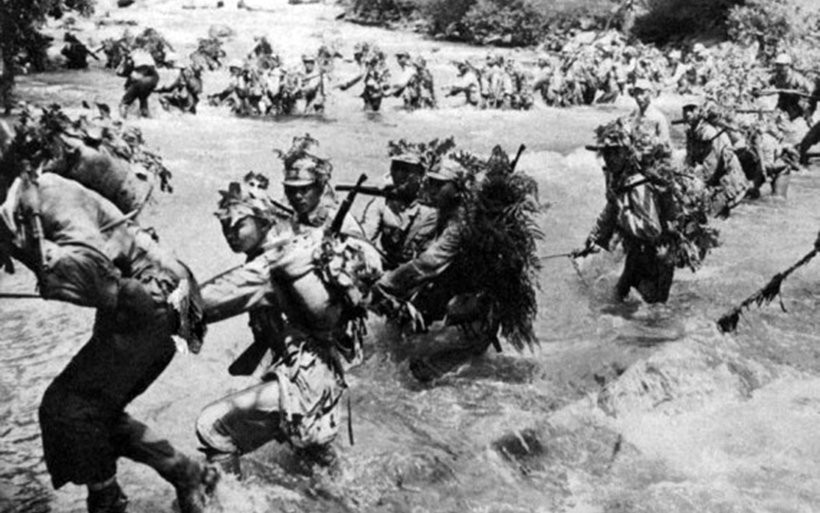Last updated on January 27th, 2023 at 05:10 am
In February of 1945, the Japanese army suffered a devastating defeat at the hands of British forces in Burma. The debacle was so bad that the Japanese troops were forced to retreat and flee into the mangrove swamps of Ramree Island.
What awaited them there was a horror beyond comprehension. This post will reveal the historical account of the Ramree Island Massacre.

The Battle of Ramree – World War II
As World War II was nearing its end in January of 1945, the island of Ramree off the coast of Burma was the scene of a desperate battle.
This battle raged for six weeks as the British forces sought to acquire an airbase to launch more coordinated attacks against the Japanese on the mainland.
Unfortunately, the battle was at a standstill until the British Royal Marines and the 36th Indian Bridge flanked the Japanese soldiers. By doing this, allied forces split the remaining party in two, leaving a group of 1,000 soldiers isolated and trapped.
The battle was bloody and grueling, leaving the Japanese soldiers exhausted yet full of defiance. Finally, the British soldiers realized the Japanese’s situation and urged them to surrender to avoid further bloodshed.
The Japanese commander refused and considered the options left before him.
The Imperial Japanese Army decided that a full retreat was in order after their defeat in Burma at the hands of British forces. So, instead of accepting their fate, they chose to make an 8-mile journey through the mangrove swamps of Ramree Island.
The Mangrove Swamps of Ramree Island
The mangrove swamps of Ramree Island were treacherous, and the British troops already knew that. So instead of following the Japanese into the swamps, they decided to wait them out.
The Japanese didn’t realize that these mangrove swamps were a death trap in disguise, but they wouldn’t figure that out until later.
The swamps were infested with mosquitoes, leeches, and snakes. Walking through the thick, sticky mud was slow and agonizing. And as if these conditions weren’t bad enough, the swamps were also home to large saltwater crocodiles.
The Japanese soldiers were soon faced with a decision: stay and die of disease or dehydration, venture further into the swamps, and risk being eaten alive.
Unfortunately, it seems that the Japanese didn’t know what awaited them in the swamp, or they were so desperate to escape that they didn’t care.
Face To Face With A Saltwater Crocodile
Military officials decided to press on, and the Japanese continued their journey through the mangrove swamps. It wasn’t long before they realized a predator lurking in the water around them.
While the idea of encountering a crocodile isn’t pleasant, it’s different when you’re up close and personal with one.
The Japanese soldiers were no match for these crocodiles. These crocodiles were actual predators, weighing over a ton and measuring up to 23 feet in length.
And they weren’t shy about attacking, either.
Crocodiles are opportunistic feeders, meaning they eat anything they can get their mouths on, making the Japanese soldiers the perfect prey. These specimens could also live more than 70 years, meaning they had plenty of time to practice their hunting skills.
Unfortunately, these reptiles are some of the most territorial species on earth and aren’t afraid to show aggression toward people, especially biting. You don’t want to get bit by this creature, though, as their bite force is the strongest in the animal kingdom.
In the end, the Japanese soldiers never stood a chance.
The Ramree Island Massacre
As you can imagine, what followed was one of the most gruesome and brutal crocodile attacks in history. Hundreds of crocodiles lurked in the murky waters, hungry for human flesh.
The crocodiles would silently stalk their prey before attacking with lightning speed; humans are no match for the saltwater crocodile when considering their power, size, and weight. Saltwater crocodiles are not to be underestimated.
During one of the nights, the British could hear the Japanese soldiers trying to fight the man-eating crocodiles, but their screams were quickly silenced.
The soldiers succumbed to the nightly menace, realizing that saltwater crocs were nocturnal, and excelled at night hunting.
Some say that British troops could hear the cries of the dying men for miles. The only account that proves any of this information comes from Bruce Stanley Wright, who participated in the battle of Ramree.
After just a few days, these ravenous creatures devoured more than 500 Japanese soldiers. Out of the 1,000 Japanese soldiers that ventured into the mangrove swamps, it’s estimated that only 480 made it out alive.
It’s estimated that 20 Japanese soldiers made it out of the other side of the swamp where British troops were waiting for them.
So while the historical accounts are unclear, the British almost certainly did encounter the 20 Japanese soldiers who explained the horrors they endured.
But, of course, the British weren’t surprised as saltwater crocodiles are notoriously territorial and will attack any human they view as a threat or potential food source.
The Aftermath
While the Ramree Island Massacre story may seem far-fetched, it is true. It’s been dubbed one of the “worst crocodile attacks” in the Guinness Book of World Records.
It just shows that you should never underestimate the power of nature.
Crocodiles may seem slow and sluggish, but they are one of the most feared predators in the world for a reason. The battle of Ramree isn’t well known, but it should be considered one of World War II’s creepiest and most bizarre episodes.
So the next time you’re going through a swamp, remember the story of the Ramree Island Massacre and be grateful that you weren’t one of the 500 Japanese soldiers who lost their lives to these crocodiles.

